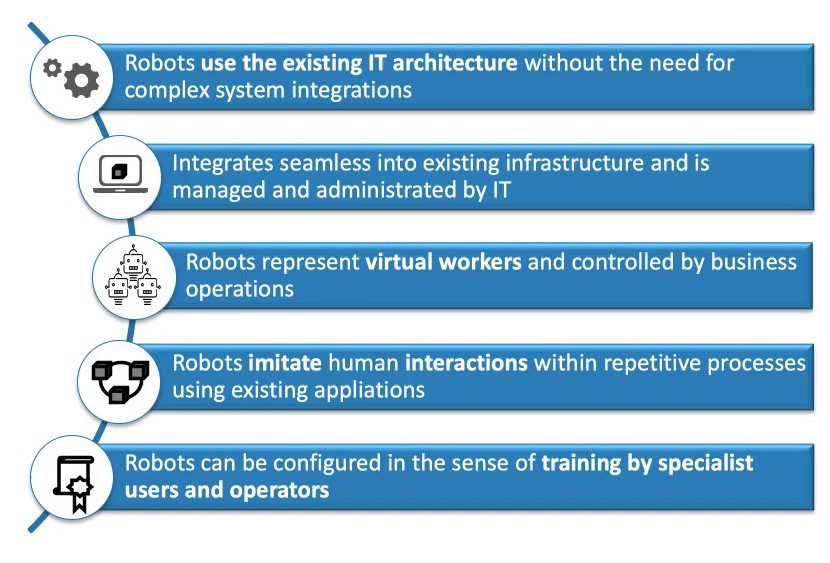What is Robotic Process Automation able to achieve?
If you have never heard of RPA, now is the time to learn about the principle and how it works. It is a business process automation technology that allows software or a “robot” to be configured so that it mimics and incorporates human actions. This is done by interaction between the robot and digital systems in order to execute various business processes in an automated manner.
Comparison: Robotic Process Automation versus APIs
In traditional workflow automation, a software developer uses application programming interfaces to create lists of different actions to connect tasks and the interface to the back end. Robotic Process Automation technology, on the other hand, uses the user interface itself. An RPA robot observes what actions users take to perform a task, captures that data, and then automatically controls application processes just as users would do manually. It interprets, triggers responses, and communicates with other systems to complete a variety of repetitive tasks.
Where is it useful to implement Robotic Process Automation?
Robotic Process Automation is not a universal solution for all business processes. However, there are some areas where it can provide excellent value. This arises from the following four characteristics of processes:
- Repeatable: Processes that run cyclically with possibly high process volumes are particularly suitable. It is important that the same steps are performed each time.
- Rule-based: Processes that are based on individual laws that do not change. If X happens, Y must follow.
- Standardized: The individual actions within these processes must be based on standards. At most, there can be minor deviations from this standard, so that the automation is straightforward.
- Structured & data-based: The processes can only contain known sequences that follow uniform structures, based on known, captured data.
If these things don’t seem like they apply to your business, you might as well have a look at another promising area of digital transformation in our article Blockchain – An answer to your question of innovative digital transformation.
“
Jana Bulkin, CEO of S2BConnected
”
What are the benefits of using RPA?
If you use RPA successfully, a whole range of advantages opens up. You don’t have to change your existing IT landscape or change application systems – RPA can be implemented without having to make extensive adjustments or investments. It actually saves expenses. Where human labor was previously required to perform and monitor processes, the tireless robot is now in action. This frees the staff from the obligation to perform these standard activities, thus reducing the general workload. Thus creating room for expert knowledge, further training and higher productivity – efficiency is increased.
Furthermore, this digital workforce increases the quality of the tasks performed because the human as a source of error is eliminated as a risk, there are no inaccuracies or mistakes due to inattention or copy-paste operations. And this high quality is at work day and night, 24/7, which ultimately increases customer satisfaction.
What are the benefits of using Robotic Process AutomationPA?
If you use RPA successfully, a whole range of advantages opens up. You don’t have to change your existing IT landscape or change application systems – RPA can be implemented without having to make extensive adjustments or investments. It actually saves expenses. Where human labor was previously required to perform and monitor processes, the tireless robot is now in action. This frees the staff from the obligation to perform these standard activities, thus reducing the general workload. Thus creating room for expert knowledge, further training and higher productivity – efficiency is increased.
Furthermore, this digital workforce increases the quality of the tasks performed because the human as a source of error is eliminated as a risk, there are no inaccuracies or mistakes due to inattention or copy-paste operations. And this high quality is at work day and night, 24/7, which ultimately increases customer satisfaction.
These challenges must be overcome
The fast pace and complexity of current conditions in the business world is also affecting Robotic Process Automation. This will increase the general pressure to change and adapt. New competitors on the financial market are one example of such challenges; so-called FinTechs are attacking established companies. Their often outdated, slow-moving systems have to compete with the very latest technology and state-of-the-art applications of these new competitors.
Innovations must be adapted to regulatory requirements, for example BASEL, Know Your Customer (KYC) or the Data Protection Regulation (GDPR). Furthermore, customer satisfaction is the top priority. Customers always demand a high level of service quality and speed. A balance must be struck between new, emerging organizational structures and agile process structures.
Example: Application of Robotic Process Automation in the financial sector
- Data synchronization: transferring data from one system to another, converting unstructured data into structured form
- New customer entry across systems: moving data and performing multiple entries
- Credit approval: compiling information from different systems
- Retail credit checks: calculate credit risks
- Account reconciliation: perform regular checks and automated closings
- eForm extraction: transfer data from forms and make system entries
- Price checks: Perform calculations and entries
- Validation to support audits
- Credit and order processing: from web form to inventory system (legacy applications)
- Updating customer data: Reading and updating entries
- Generate reports across systems
- Fraud detection by tracking account activity
How should you approach Robotic Process Automation?
The first step is to do the groundwork. This means, in the specific case of your company, analyzing the business processes in terms of regularities and routines with a high amount of manual interactions. This is followed by defining the associated actions and documenting them precisely. All these processes must then be monitored and optimized in an organized manner to guarantee quality management from the very beginning. Only then will it be worthwhile to start with the selection of a service provider and the actual implementation of Robotic Process Automation.
Product selection in 4 steps
- Request for Information (RFI): duration approx. 2 weeks
- Compilation of evaluation criteria
- Definition of strategic goal and project scope
- Creation of a long list of different providers e.g. with Gartner or Forrester
- Obtaining further information from providers through questionnaire
- Request for Proposal (RFP): duration approx. 4 weeks
- Evaluation of the RFI feedback
- Creating a short list based on the responses to the questionnaire
- Requesting proposals from vendors to obtain an initial estimate
- Proof of Concept (POC): duration approx. 2-4 weeks
- Defining the scope of the proof of concept and expected outcomes
- Staff the project team, in-house or off-site
- Preparing infrastructure if necessary
- Defining a potential implementation plan and conduct competency analysis
- Preparing a management presentation
- Proof of Value (POV)
- Evaluate your process landscape
- Identify your problematic areas
- Scout and evaluate related processes
- Determine the ones with the biggest impact (prove the value)
- Check for any dependencies within the project/product portfolio
- Define the implementation roadmap
- Calculate the break even, checking whether investments are profitable
- Decision for the most suitable offer
After you have selected the most suitable offer, the next step is to show your appreciation for the efforts of the other providers and to give them dedicated feedback. Now you can venture into implementation, in which the so-called Center of Excellence takes on a leading role. It takes care of the actual implementation into the existing IT infrastructure and regulates the standards for the robotic process automation deployment, determines best practices and screens the support and training capacities within your company.
As you can see, Robotic Process Automation is a comparatively easy and quick-to-implement technology that can take you a long way along the path to the digitization of your business processes. Do you no longer want to work without these easily accessible advantages? We look forward to getting to know your project and are happy to stand by your side as professional consultants.





Thanks for some other informative website. The place else may just I am getting that type of info written in such an ideal approach?
I have a undertaking that I am simply now running on, and I’ve been at the glance out for such information.
Just stay tuned! Thank you.
You are welcome! Happy that you found it valuable and that you could make something out of it for yourself.
Have you ever thought about writing an e-book or guest authoring on other blogs?
I have a blog based upon on the same subjects you discuss and would love to have you share some stories/information. I know my readers would enjoy your work.
If you’re even remotely interested, feel free to shoot me an e-mail.
Thank you! Interesting indeed.
Would love doing it. Will PM you.
Hi there! I just would like to offer you a big thumbs up for the excellent information you have got right here on this post. I will be returning to your website for more soon.
Thank you @jack.oshea@zoho.com!
Thank you! Welcome, and please stay tuned.
With havin so much content, do you ever run into any issues of plagorism or copyright violation? My blog has a lot of completely unique content I’ve either created myself or outsourced, but it seems a lot of it is popping it up all over the internet without my authorization. Do you know any methods to help stop content from being ripped off? I’d truly appreciate it.
I was recommended this blog by my cousin. I’m not sure whether this post is written by him as nobody else know such detailed about my problem.
You are amazing! Thanks!
I think this is one of the so much important information for me. And i’m satisfied studying your article. But wanna observation on few common things, The website style is wonderful, the articles is actually excellent :D.
Good process, cheers
Hello very cool blog!! Guy .. Beautiful .. Superb .. I’ll bookmark your blog and take the feeds also?
I’m satisfied to search out numerous helpful information right here within the submit, we’d like develop more strategies on this regard, thank you
for sharing. . . . . .
Hey, thanks for your nice feedback. Just PM me.
This text is invaluable. When can I find out more?
Here :-). Thank you for your nice Feedback.
Howdy! I know this is kinda off-topic however, I’d figured I’d ask.
Would you be interested in exchanging links or maybe guest authoring a blog post or vice versa?
My site covers a lot of the same subjects as yours, and I believe we could greatly benefit from each other. If you are interested, feel free to shoot me an email. I look forward to hearing from you! Fantastic blog by the way!
Let me know your blog, please.
Great info. Lucky me, I ran across your blog by chance (stumbleupon).
I’ve saved as a favorite for later!
Hi there, I want to subscribe for this weblog to obtain latest updates, so where can i do it please assist.
https://s2bconnected.com/en/always-up-to-date-with-s2bc-digest/
Excellent post. I used to be checking continuously this blog and I’m inspired! Extremely useful information specially the ultimate phase 🙂 I deal with such info much. I used to be seeking this certain info for a very lengthy time. Thanks and best of luck.
When I initially commented I clicked the “Notify me when new comments are added” checkbox and now each time a comment is added I get three e-mails with the same comment.
Is there any way you can remove me from that service?
Many thanks!
Thank you for your feedback – we will try to solve and return asap to you.
Warmest, S2BC
What’s up, this weekend is nice designed for me, because this time i am reading this fantastic educational article here at my house.
Asking questions are really good thing if you are not understanding anything totally, but this article offers good understanding yet.